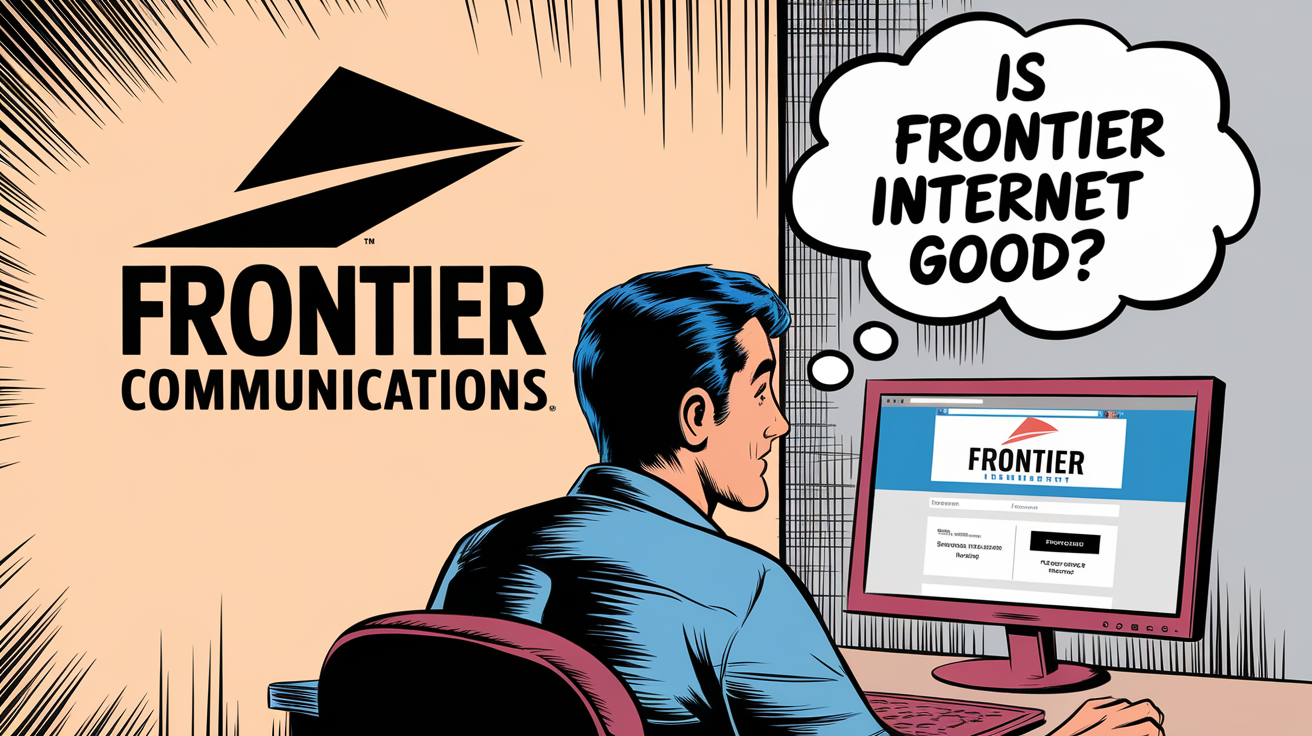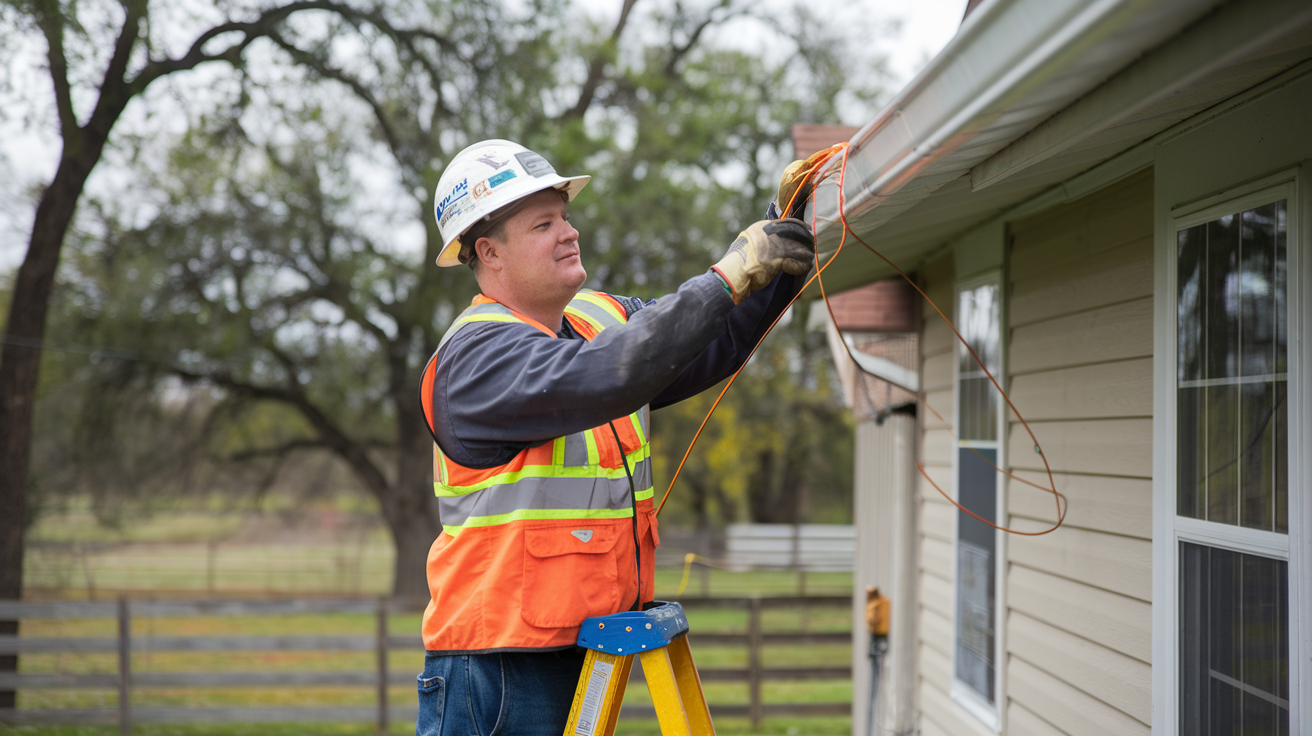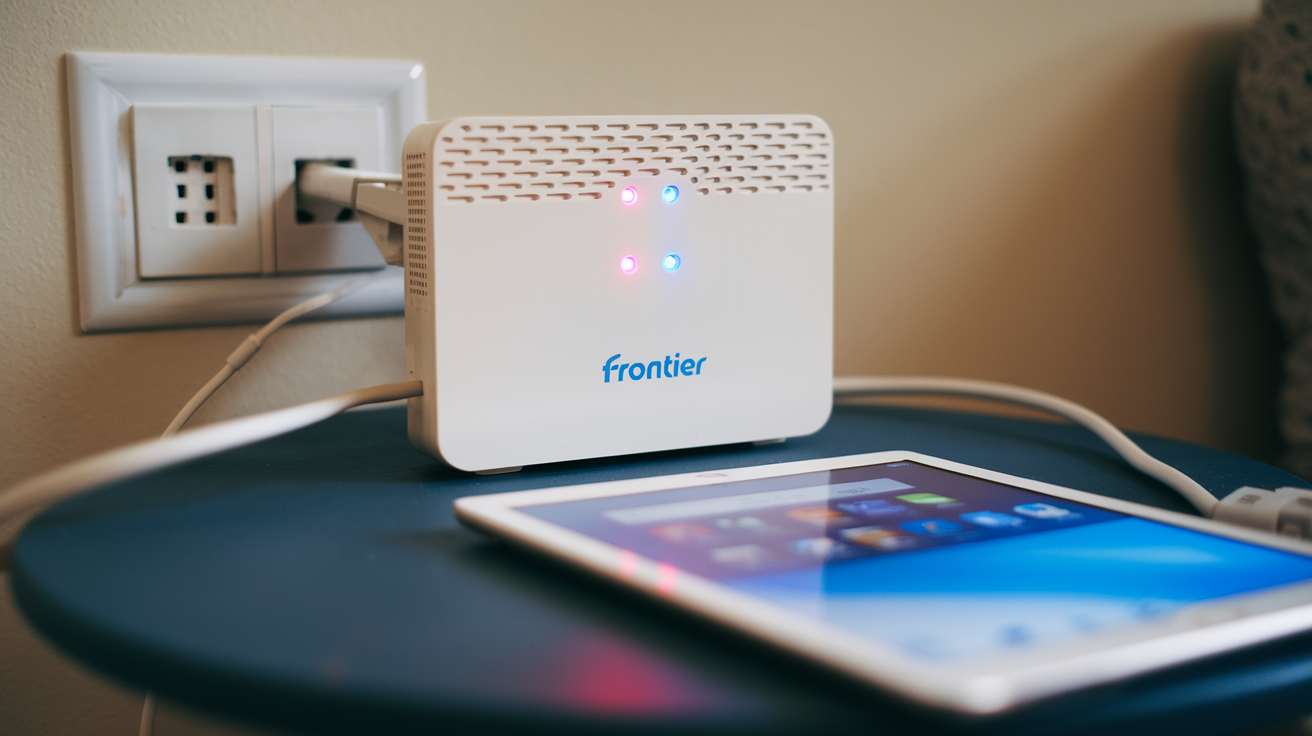
Is Frontier Internet Good? A Comprehensive Review for Better Decisions
Deciding on an internet provider can be a daunting task. This in-depth review of Frontier Internet aims to provide you with the clarity needed to make an informed choice in 2025. We'll explore their technologies, performance, pricing, and customer service to determine if Frontier is the right fit for your home or business.
Frontier Internet: An Overview
Frontier Communications, a prominent player in the telecommunications industry, offers a range of internet services across various regions of the United States. While not as ubiquitous as some national giants, Frontier has been actively expanding its network, particularly its fiber optic infrastructure, in an effort to compete more effectively. Understanding their service offerings requires a look at the underlying technologies they employ and the geographical limitations that often accompany them.
Founded in 1935, Frontier has evolved significantly from its early days as a local telephone company. Today, it operates in approximately 25 states, with a significant presence in areas where larger providers may have less coverage. This makes Frontier a crucial option for many consumers, especially in suburban and rural communities. The company's strategic focus in recent years has been on upgrading its network to deliver faster and more reliable internet speeds, primarily through the deployment of fiber-to-the-home (FTTH) technology. However, DSL (Digital Subscriber Line) remains a significant part of their offering, particularly in areas where fiber deployment is not yet complete or economically feasible.
The perception of Frontier Internet can vary widely depending on the user's location and the type of service they have access to. Those with fiber optic connections often report excellent performance, while those relying on DSL may experience more moderate speeds and reliability. This review will delve into these nuances to provide a balanced perspective, helping you understand what to expect from Frontier in 2025.
Understanding Frontier's Internet Technologies
Frontier primarily offers two types of internet technologies: Fiber Optic and DSL. The performance, speed, and reliability you experience will largely depend on which of these technologies is available in your area.
Fiber Optic Internet
Fiber optic internet is the gold standard in modern broadband technology. Frontier's fiber network utilizes thin strands of glass or plastic to transmit data as pulses of light. This method offers several distinct advantages over traditional copper wiring:
- Unmatched Speeds: Fiber optic cables can carry data at speeds significantly faster than DSL. Frontier offers symmetrical download and upload speeds with its fiber plans, meaning you can download and upload content at the same rapid pace. This is crucial for activities like video conferencing, online gaming, and uploading large files. In 2025, Frontier's fiber plans can offer speeds ranging from 500 Mbps to over 1 Gbps (1000 Mbps), with some premium plans potentially reaching even higher.
- Exceptional Reliability: Fiber optic cables are less susceptible to interference from electromagnetic signals, weather conditions, and physical damage compared to copper lines. This translates to a more stable and consistent internet connection with less downtime.
- Low Latency: The speed at which light travels through fiber results in very low latency, which is the delay between sending a command and receiving a response. This is vital for real-time applications like online gaming, live streaming, and video calls, ensuring a smooth and responsive experience.
- Future-Proofing: Fiber optic technology has a high capacity and can be upgraded to support even greater speeds in the future without requiring extensive infrastructure changes.
Frontier's commitment to expanding its fiber network is a key differentiator. As of 2025, they are actively investing in new fiber buildouts in various communities, aiming to bring these superior internet capabilities to more households. If fiber optic service is available from Frontier in your area, it is almost always the recommended choice.
DSL Internet
DSL (Digital Subscriber Line) internet service uses existing copper telephone lines to transmit data. While it was a significant upgrade from dial-up, it is generally considered an older technology compared to fiber optics and cable internet. Frontier still offers DSL in many areas where fiber is not yet available.
- Speeds: DSL speeds are dependent on the distance from the customer's home to the local telephone company's central office (CO). The closer you are, the faster the speeds. Frontier's DSL plans typically offer download speeds ranging from 1 Mbps to around 100 Mbps. Upload speeds are significantly slower than download speeds, often in the range of 1 Mbps to 10 Mbps. For households with multiple users or heavy internet usage (streaming, gaming, large downloads), these speeds can become a bottleneck.
- Availability: DSL has a much wider availability than fiber because it leverages existing telephone infrastructure. This makes it a viable option for many customers in rural or less densely populated areas.
- Shared Bandwidth: While DSL doesn't suffer from the same neighborhood congestion issues as some older cable technologies, the bandwidth is still shared to some extent within the local loop.
- Interference: DSL can be susceptible to interference from electrical appliances and other sources, which can affect connection stability and speed.
For users with basic internet needs, such as occasional web browsing, email, and light streaming, Frontier's DSL service might be adequate. However, for more demanding applications, it will likely fall short of expectations, especially when compared to fiber or even modern cable offerings.
Performance Analysis: Speed, Latency, and Reliability
When evaluating any internet service, speed, latency, and reliability are paramount. Let's break down how Frontier's offerings perform in these critical areas, considering both their fiber and DSL services.
Speed Metrics: Download and Upload
Fiber Optic: As mentioned, Frontier's fiber optic internet is designed for high-speed performance. In 2025, typical advertised speeds for their fiber plans include:
- 500 Mbps Download / 500 Mbps Upload: Suitable for most households, supporting multiple users streaming in HD, online gaming, and video conferencing.
- 1 Gig (1000 Mbps) Download / 1 Gig (1000 Mbps) Upload: Ideal for power users, large households, and those who frequently download or upload large files, stream 4K content, or engage in professional remote work.
These speeds are symmetrical, meaning your upload capacity is as robust as your download capacity. This is a significant advantage for content creators, streamers, and anyone participating in frequent video calls. Real-world speeds on fiber are generally very close to advertised speeds, with minimal fluctuations.
DSL: Frontier's DSL speeds are considerably more variable and generally lower. Advertised speeds can range:
- Up to 100 Mbps Download / Up to 10 Mbps Upload: This is often the maximum available DSL speed from Frontier. In many areas, speeds will be much lower, sometimes as low as 10-25 Mbps download and 1-3 Mbps upload.
The significant difference in upload speeds for DSL is a major limitation. If you're uploading photos to social media, backing up files to the cloud, or participating in video conferences where your video is being sent, you'll notice the bottleneck. For context, a 4K movie download can take hours on a 25 Mbps connection, while it might take mere minutes on a 1 Gbps fiber connection. Conversely, uploading a large video file (e.g., 10 GB) could take over 10 hours on a 3 Mbps DSL upload speed but less than 20 minutes on a 1 Gbps fiber upload speed.
Latency: The Unsung Hero of Online Experience
Latency, often measured in milliseconds (ms), refers to the time it takes for data to travel from your device to a server and back. Lower latency means a more responsive internet experience.
Fiber Optic: Fiber optic internet boasts exceptionally low latency. Frontier's fiber connections typically exhibit latency in the range of 5-20 ms. This is crucial for:
- Online Gaming: Low latency minimizes lag, providing a competitive edge and a smoother gameplay experience.
- Video Conferencing: Reduces delays in conversations, making interactions feel more natural and less frustrating.
- Real-time Applications: Essential for remote control systems, financial trading platforms, and other time-sensitive applications.
DSL: DSL internet generally has higher latency than fiber. Latency for DSL can range anywhere from 20 ms to over 100 ms, depending on factors like distance from the CO and network congestion. While 20-30 ms might be acceptable for casual browsing and streaming, higher latency can lead to noticeable delays in online gaming, choppy video calls, and a generally less snappy feel to internet usage.
Reliability: Uptime and Connection Stability
Reliability refers to how consistently your internet connection is available and performing as expected. This includes uptime (the percentage of time the service is operational) and stability (freedom from frequent disconnections or speed drops).
Fiber Optic: Fiber optic networks are inherently more reliable. They are:
- Less Prone to Interference: Unlike copper, light signals are not affected by electromagnetic interference, weather, or power surges in the same way.
- Physically More Durable: While not indestructible, fiber optic cables are generally more resilient than copper lines.
Frontier's fiber services are known for their high uptime, often exceeding 99.9%. This means fewer unexpected outages and a more dependable connection for critical tasks.
DSL: DSL reliability can be more variable. Factors that can impact it include:
- Distance from CO: The further you are, the weaker the signal, leading to potential instability.
- Copper Line Quality: Older or damaged copper lines can cause intermittent issues.
- Environmental Factors: DSL can be more susceptible to interference from storms or electrical equipment.
While Frontier strives for good reliability with its DSL service, it's generally considered less stable than fiber. Users may experience occasional drops in speed or brief disconnections, especially during peak usage times or adverse weather conditions.
Frontier Internet Plans and Pricing in 2025
Frontier's pricing structure varies significantly based on the technology (fiber vs. DSL), speed tier, and your geographical location. It's crucial to check availability for your specific address to get accurate pricing.
Fiber Optic Plans
Frontier's fiber plans are designed to offer competitive pricing for high-speed, reliable internet. As of early 2025, you can expect plans like:
- Fiber 500 Mbps: Often priced around $60-$70 per month. This plan is a strong contender for most households, offering excellent symmetrical speeds for a reasonable cost.
- Fiber 1 Gig (1000 Mbps): Typically priced around $70-$90 per month. This plan is for users who need the absolute fastest speeds available for demanding online activities.
Key Features of Frontier Fiber Plans:
- Symmetrical Speeds: Download and upload speeds are the same.
- No Data Caps: Generally, Frontier fiber plans do not impose data caps, allowing for unlimited usage.
- Free Installation: Often, Frontier offers free installation for new fiber customers, which can save you a significant upfront cost.
- No Annual Contracts: Many fiber plans are offered on a month-to-month basis, providing flexibility.
It's important to note that advertised prices often reflect introductory offers or discounts for the first 12-24 months. After this period, the price may increase. Always confirm the price after the promotional period ends.
DSL Plans
Frontier's DSL plans are generally more affordable but come with significantly lower speeds and asymmetrical bandwidth.
- DSL 100 Mbps: Prices can range from $40-$60 per month, depending on the exact speed tier and location.
- Lower Speed DSL Tiers (e.g., 25 Mbps, 50 Mbps): May be available for $30-$50 per month.
Key Features of Frontier DSL Plans:
- Asymmetrical Speeds: Upload speeds are much lower than download speeds.
- Potential Data Caps: Some DSL plans might have data caps, although Frontier has been moving away from these. It's essential to verify this.
- Installation Fees: Installation fees might apply for DSL, though sometimes waived as a promotion.
- Contracts: Some DSL plans may require a 12-month contract.
DSL is a budget-friendly option for basic internet needs, but the performance trade-offs are substantial compared to fiber.
Understanding Fees and Contracts
Beyond the monthly service fee, be aware of potential additional costs:
- Installation Fees: While often waived for fiber, DSL installations might incur a fee ($50-$150 is common).
- Equipment Rental Fees: Frontier may charge a monthly fee for modem/router rental. Purchasing your own compatible equipment can save money long-term.
- Early Termination Fees (ETFs): If you sign a contract for DSL service, breaking it early can result in substantial fees. Fiber plans are often contract-free, offering more flexibility.
- Price Increases: As noted, introductory offers have an expiration date. Factor in the post-promotional pricing when budgeting.
Always read the fine print and ask specific questions about all fees and contract terms before signing up.
Customer Service and Support
Customer service is a critical aspect of any internet provider's offering, and experiences with Frontier can be mixed. Based on customer feedback and industry reviews from 2025:
- Support Channels: Frontier offers multiple support channels, including phone support, online chat, and a knowledge base on their website.
- Fiber vs. DSL Support: Customers with fiber optic service often report a more positive support experience, possibly due to the higher-tier nature of the service and fewer technical issues.
- Wait Times: Like many large telecommunications companies, Frontier can experience long wait times for phone support, especially during peak hours.
- Technical Expertise: The technical expertise of support staff can vary. Some customers report quick and effective problem resolution, while others find it challenging to get their issues addressed.
- Online Resources: Frontier's website provides a decent self-help portal with FAQs and troubleshooting guides, which can be helpful for common issues.
Tips for Dealing with Frontier Customer Service:
- Be Prepared: Have your account number, modem details, and a clear description of the problem ready before calling.
- Document Everything: Keep records of dates, times, names of representatives you speak with, and what was discussed or promised.
- Escalate if Necessary: If you're not getting a satisfactory resolution, politely ask to speak with a supervisor or a higher tier of support.
- Utilize Online Tools: For simpler issues, the online chat or self-help resources might be faster.
Overall, while Frontier's customer service is functional, it's not always lauded as exceptional. Managing expectations and being proactive in seeking solutions is key.
The Verdict: Pros and Cons of Frontier Internet
To help you make a decision, here's a consolidated view of Frontier's strengths and weaknesses in 2025.
Frontier's Strengths
- Excellent Fiber Optic Speeds: If fiber is available, Frontier offers competitive symmetrical speeds (up to 1 Gbps and beyond) that rival or exceed many competitors. This is a major advantage for demanding internet users.
- Low Latency with Fiber: Fiber connections provide low latency, which is crucial for gaming, video conferencing, and real-time applications.
- Expanding Fiber Network: Frontier is actively investing in and expanding its fiber infrastructure, bringing better internet to more areas.
- No Data Caps on Fiber: Generally, Frontier's fiber plans come with unlimited data, eliminating concerns about exceeding usage limits.
- Contract-Free Fiber Options: Many fiber plans offer month-to-month flexibility, avoiding long-term commitments.
- Competitive Pricing for Fiber: When compared to other fiber providers, Frontier's pricing for its high-speed plans can be very attractive, especially during promotional periods.
- Wider Availability for DSL: For areas where fiber is not yet an option, Frontier's DSL provides a baseline internet service leveraging existing telephone infrastructure.
Frontier's Weaknesses
- Limited Fiber Availability: Fiber optic service is not available everywhere. Many customers are still limited to DSL.
- Variable DSL Performance: DSL speeds and reliability are heavily dependent on distance from the central office and can be significantly slower than fiber or cable options.
- Lower Upload Speeds on DSL: DSL's asymmetrical nature means upload speeds are a major bottleneck for many modern online activities.
- Customer Service Can Be Inconsistent: While functional, customer service experiences can vary, with potential for long wait times and mixed resolution effectiveness.
- Potential for Price Increases: Introductory pricing on fiber plans will eventually expire, leading to higher monthly bills.
- DSL Reliability Issues: DSL can be more prone to interference and instability than fiber, especially in areas with older infrastructure.
Frontier vs. The Competition
To truly assess if Frontier Internet is good, it's essential to see how it stacks up against other major providers in 2025. Availability varies by region, so this is a general comparison.
Frontier vs. Verizon
Both Frontier and Verizon are major players, particularly in the Northeast and parts of the Midwest. They both offer fiber optic internet, which is where the most direct comparison lies.
- Fiber Speeds: Both providers offer multi-gigabit fiber speeds. Verizon's Fios Gigabit Connection (up to 940/880 Mbps) is comparable to Frontier's 1 Gig fiber. Verizon may also offer higher multi-gigabit tiers in some areas.
- Pricing: Pricing is often competitive, with both offering introductory rates. Verizon Fios tends to be slightly more expensive for comparable speeds but may offer better bundle deals.
- Availability: Verizon Fios is more concentrated in specific regions (e.g., Mid-Atlantic, parts of New England, California), while Frontier has a broader, though less dense, footprint.
- Customer Service: Both have had mixed reviews, but Verizon often edges out Frontier slightly in customer satisfaction surveys for its Fios service.
Verdict: If both are available, Verizon Fios often has a slight edge in perceived reliability and customer service for its fiber product. However, Frontier's fiber can be a more budget-friendly option, especially with promotions.
Frontier vs. AT&T
AT&T offers a mix of technologies, including fiber (AT&T Fiber) and DSL (AT&T Internet). Frontier competes with both.
- Fiber: AT&T Fiber offers plans up to 5 Gbps in select areas, surpassing Frontier's current widely advertised 1 Gig. AT&T's fiber pricing is also competitive, often with similar promotional structures.
- DSL: AT&T's DSL service is similar to Frontier's in terms of limitations – slower speeds, asymmetrical bandwidth, and distance dependency.
- Availability: AT&T has a massive footprint across many states, often overlapping with Frontier's service areas.
- Bundling: AT&T offers extensive bundling options with its TV (DIRECTV) and mobile services, which can be attractive for some consumers.
Verdict: For fiber, AT&T generally offers higher potential speeds and a broader fiber footprint. For DSL, the comparison is often a wash, with both offering similar performance limitations. If fiber is available from either, it's the clear choice.
Frontier vs. Xfinity (Comcast)
Xfinity, powered by Comcast, is a cable internet provider that offers high speeds and widespread availability, often competing directly with Frontier's fiber and DSL services.
- Speeds: Xfinity offers a wide range of cable internet speeds, with plans reaching up to 2 Gbps in many areas. While cable speeds are generally very fast, they are typically shared bandwidth and are asymmetrical (lower upload speeds than download). Frontier's fiber offers symmetrical speeds, which is a significant advantage for uploads.
- Pricing: Xfinity's pricing can be aggressive, especially with bundles. However, their plans often come with data caps (though these are increasing) and higher prices after promotional periods. Frontier's fiber, being symmetrical and often contract-free, can be more appealing for long-term value and usage flexibility.
- Availability: Xfinity has one of the largest cable footprints in the US, often available in more areas than Frontier's fiber.
- Reliability: Cable internet can be subject to neighborhood congestion, leading to speed fluctuations during peak hours, though modern cable networks are quite robust. Frontier's fiber is generally more stable.
Verdict: If your priority is the fastest possible download speeds and you don't upload large files frequently, Xfinity might be a strong contender. However, for symmetrical speeds, better reliability, and often a more straightforward pricing structure (especially on fiber), Frontier's fiber is superior.
Who is Frontier Internet Best Suited For?
Based on the analysis, Frontier Internet is best suited for specific types of users:
- Residents in Frontier Fiber Expansion Areas: If Frontier has recently expanded its fiber optic network to your neighborhood, this is likely one of your best options for high-speed, reliable, and symmetrical internet. This is ideal for:
- Gamers requiring low latency.
- Remote workers needing consistent video conferencing and fast uploads.
- Families with multiple users streaming, gaming, and browsing simultaneously.
- Content creators uploading large files.
- Budget-Conscious Users with Basic Needs (DSL): If fiber is not available and your internet usage is limited to basic web browsing, email, and occasional light streaming, Frontier's DSL service can be an affordable choice.
- Those Seeking Contract-Free Internet: Frontier's fiber plans often offer month-to-month flexibility, which is attractive for renters or those who prefer not to be locked into long-term contracts.
- Consumers in Underserved Areas: In regions where other high-speed providers have limited or no presence, Frontier can be a vital provider of broadband internet, especially if they offer fiber.
Conversely, if you are in an area with limited Frontier fiber availability and require consistently high upload speeds or the absolute fastest download speeds available (e.g., multi-gigabit), you might find better options with other providers like AT&T Fiber or Xfinity, depending on your location.
Making the Decision: Key Questions to Ask Yourself
Before committing to Frontier Internet, consider these questions:
- What type of internet service is available at my address? (Fiber is vastly superior to DSL.)
- What are my typical internet usage habits? (Streaming, gaming, remote work, basic browsing?)
- How many people will be using the internet in my household, and on how many devices?
- What are my download and upload speed requirements? (Consider future needs as well.)
- What is my budget for internet service? (Factor in introductory pricing vs. long-term costs.)
- Do I prefer a contract-free service, or am I comfortable with a 12-24 month commitment?
- How important is low latency for my online activities?
- What is the reputation of Frontier's service in my specific neighborhood? (Online reviews, local forums can help.)
- What are the competitor offerings in my area, and how do they compare in terms of speed, price, and technology?
Answering these questions will help you align your needs with what Frontier can realistically offer and whether it's the best choice for you compared to alternatives.
Conclusion: Is Frontier Internet Good for You?
In conclusion, the answer to "Is Frontier Internet good?" is nuanced and heavily dependent on your location and the technology available. If you are fortunate enough to have access to Frontier's fiber optic internet in 2025, then yes, Frontier Internet is likely a very good choice. Their fiber plans offer impressive symmetrical speeds, low latency, and generally high reliability, making them competitive with the best providers in the market. The contract-free nature of many fiber plans adds significant value and flexibility.
However, if your only option is Frontier's DSL service, the experience will be considerably different. While it can serve basic internet needs at an affordable price, it falls short of modern standards for speed, upload capacity, and reliability, especially when compared to fiber or even robust cable offerings from competitors. In such cases, while Frontier might be a necessary option, it's essential to manage expectations and explore all alternatives thoroughly.
Ultimately, Frontier is making strides with its fiber expansion, positioning itself as a strong contender for high-speed internet in the areas it serves. Always verify availability at your specific address and compare the available plans, speeds, and pricing against competitors to make the most informed decision for your household's needs.






